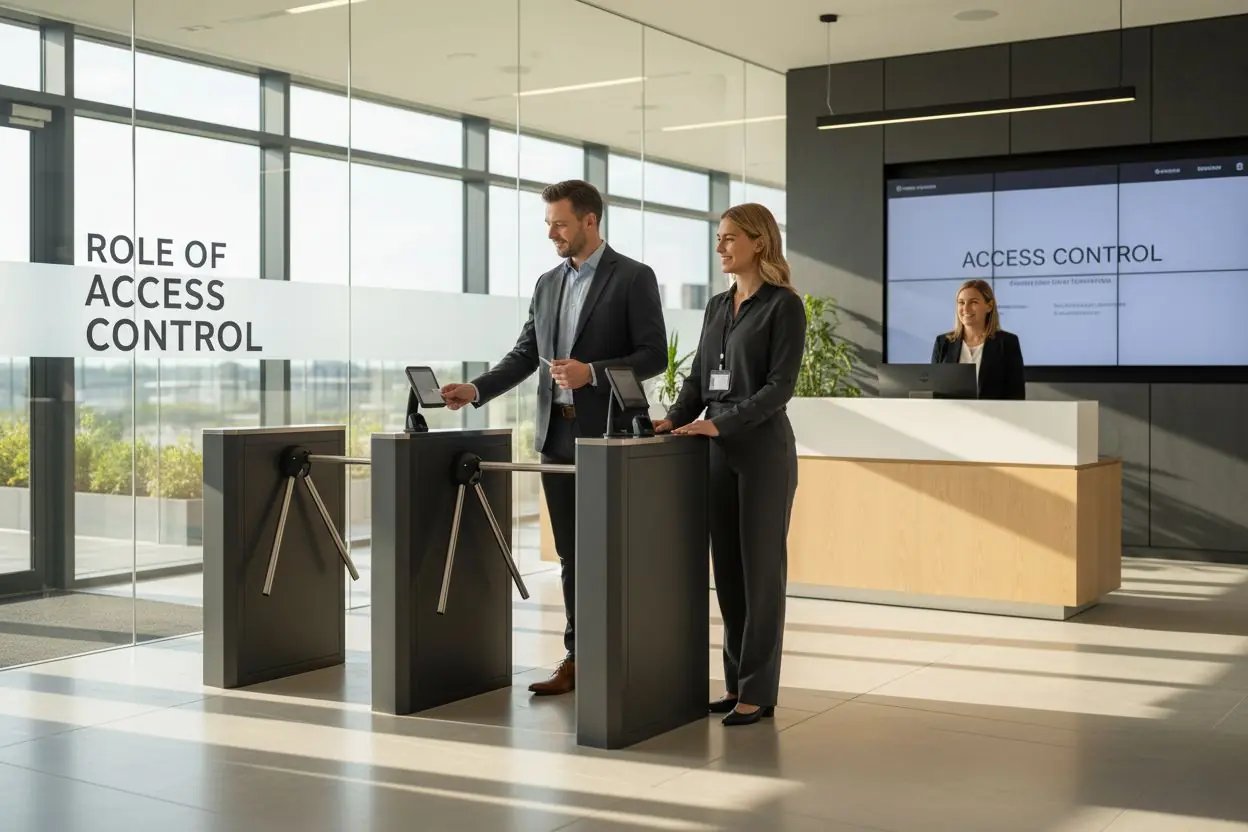Access control sounds technical but it shapes almost every moment you spend in a workplace or online. Surprisingly, nearly half of small businesses targeted by cyber attacks lacked proper access control measures. Most people think passwords are the main defence and that is enough. The reality is layered permissions and smarter verification methods are what actually keep your physical and digital assets safe.
Table of Contents
- What Is Access Control And Its Importance?
- Why Access Control Matters For Small Businesses
- How Access Control Mechanisms Function
- Core Concepts Of Access Control Systems
- Real-World Examples Of Access Control Applications
Quick Summary
| Takeaway | Explanation |
|---|---|
| Access control is essential for security. | It regulates who can access digital and physical resources, preventing unauthorized interactions. |
| Small businesses must prioritize access control. | Given their vulnerabilities, strategic access control is vital for their cybersecurity and overall survival. |
| Implement multi-layered authentication methods. | Using diverse authentication techniques enhances security by requiring multiple proofs of identity before granting access. |
| Establish clear user roles and permissions. | Defining roles ensures only necessary access rights are granted, minimizing security risks. |
| Regularly audit access permissions. | Audits help maintain proper access controls and can prevent unauthorized access by adjusting permissions as needed. |
What is Access Control and Its Importance?
Access control represents a fundamental security strategy that determines who can enter or utilise specific resources within an organisational network. At its core, this mechanism protects critical digital and physical assets by regulating permissions and preventing unauthorised interactions.
Understanding the Basic Concept
In the realm of business technology, access control functions like a sophisticated digital gatekeeper. Learn more about cybersecurity strategies to understand how organisations protect their most valuable information assets. The primary goal is simple yet powerful: ensure that only authenticated and authorised individuals can interact with specific systems, data, or physical spaces.
Key components of an effective access control system include:
- Authentication mechanisms that verify user identities
- Authorization protocols that define precise permission levels
- Comprehensive monitoring and logging of access attempts
Why Access Control Matters for Business Security
According to Australian Cyber Security Centre, robust access control is critical in preventing potential security breaches. For Brisbane businesses, this means creating multiple layers of protection that shield sensitive information from potential cyber threats.
Businesses implementing strategic access control can achieve several critical security objectives:
- Minimise internal and external security risks
- Maintain compliance with industry regulations
- Create transparent accountability for system interactions
By establishing clear boundaries and permissions, organisations transform their digital infrastructure from vulnerable networks into secure, controlled environments where every interaction can be tracked, verified, and managed with precision.

Why Access Control Matters for Small Businesses
Small businesses in Brisbane and across Queensland face unique cybersecurity challenges that make access control more than just a technical requirement. It has become a critical survival strategy in an increasingly complex digital landscape.
Financial and Reputational Protection
For small businesses, a single security breach can be catastrophic. Explore the top cybersecurity threats facing SMBs to understand the potential risks. According to the Australian Cyber Security Centre, small businesses are increasingly targeted by cybercriminals precisely because they often lack sophisticated security infrastructure.
The potential consequences of inadequate access control include:
- Significant financial losses from data theft
- Permanent damage to business reputation
- Potential legal liabilities and compliance penalties
Practical Risk Mitigation
Access control provides small businesses with a structured approach to managing digital risks. By implementing granular permissions and robust authentication protocols, organisations can create multiple layers of protection that substantially reduce vulnerability.
Key strategic benefits for small businesses include:
- Preventing unauthorized data access
- Tracking and monitoring user interactions
- Creating transparent accountability mechanisms
Brisbane small business owners must recognize that access control is not an optional luxury but a fundamental requirement for sustainable digital operations. The investment in comprehensive access control represents a proactive approach to cybersecurity that can potentially save thousands in potential breach recovery costs.
How Access Control Mechanisms Function
Access control mechanisms operate as sophisticated digital gatekeepers that manage, monitor, and regulate user interactions with organisational resources through systematic authentication and authorisation processes.
Authentication Protocols
Learn more about data security strategies that complement access control frameworks. Authentication represents the critical first step where users prove their identity before gaining system entry.
VIDEO:video_content] According to [Australian Signals Directorate, robust authentication typically involves multiple verification layers:
- Username and password combinations
- Biometric verification methods
- Hardware security tokens
- Multi factor authentication techniques
Permission Mapping and Role Assignment
Once authenticated, users encounter granular permission structures that determine precisely what actions they can undertake. These permission frameworks map individual user roles against specific resource access levels, creating a structured environment where each team member receives exactly the digital capabilities required for their professional responsibilities.
The access control mechanism evaluates three fundamental questions during each interaction:
- Who is attempting to access the resource?
- What specific resource is being requested?
- What level of interaction is permitted?
By systematically answering these questions, organisations create a dynamic security ecosystem that adapts to changing operational requirements while maintaining stringent protective protocols. Brisbane businesses can implement these mechanisms to transform their digital infrastructure from vulnerable networks into controlled, transparent environments where every interaction becomes traceable and manageable.
Core Concepts of Access Control Systems
Access control systems represent sophisticated technological frameworks designed to manage, regulate, and secure organisational digital interactions through strategic permission management and identity verification processes.
Fundamental Access Control Models
Understand comprehensive cybersecurity approaches that complement access control strategies. According to the Australian Cyber Security Centre, different access control models provide unique approaches to managing digital permissions
![]() :
:
- Discretionary Access Control (DAC)
- Mandatory Access Control (MAC)
- Role Based Access Control (RBAC)
- Rule Based Access Control
Principles of Permission Granularity
Effective access control systems operate on the principle of least privilege, ensuring that users receive minimal system access necessary to complete their specific professional tasks. This strategic approach minimises potential security vulnerabilities by restricting unnecessary permissions.
Key considerations for implementing robust permission structures include:
- Defining clear user roles and responsibilities
- Creating precise access level hierarchies
- Implementing regular permission audits
- Maintaining comprehensive access logs
By developing intricate, adaptable access control systems, organisations create dynamic security environments that protect critical digital assets while enabling efficient operational workflows.
The following table compares the four foundational access control models discussed in the article, helping clarify their mechanisms and typical business uses.
| Access Control Model | How It Works | Typical Business Use |
|---|---|---|
| Discretionary Access Control (DAC) | Resource owners control access permissions for their own assets | Small businesses and collaborative environments |
| Mandatory Access Control (MAC) | System-enforced rules restrict access based on classifications | Government, defence, highly regulated sectors |
| Role Based Access Control (RBAC) | Permissions allocated to job roles rather than individuals | Medium-large enterprises, departmental workflows |
| Rule Based Access Control | Access determined by set system rules (e.g., time, location) | Specialised or dynamic operational scenarios |
Real-World Examples of Access Control Applications
Access control transcends theoretical concepts, manifesting in practical applications across various industries and organisational environments. These real-world implementations demonstrate the critical role of strategic permission management in protecting digital and physical assets.
Physical Security Implementations
Explore comprehensive data security solutions that complement physical access control strategies. According to the Australian Institute of Professional Intelligence Officers, physical access control systems protect sensitive environments through sophisticated technological interventions:
- Biometric entry systems in corporate headquarters
- Electronic keycard access for restricted areas
- Security checkpoints with multi factor authentication
- Visitor management and tracking protocols
Digital Infrastructure Protection
In digital contexts, access control becomes a complex network of permissions governing interactions between users, systems, and critical information resources. Brisbane businesses increasingly deploy advanced mechanisms to create granular security architectures that adapt to evolving technological landscapes.
Typical digital access control scenarios include:
- Cloud storage permission management
- Enterprise resource planning system restrictions
- Customer relationship management platform controls
- Financial transaction authorization protocols
By implementing context aware, intelligent access control systems, organisations transform potential security vulnerabilities into robust, transparent, and manageable digital ecosystems that protect critical business assets while enabling efficient operational workflows.
Secure Your Brisbane Business with Proven Access Control Solutions
Understanding the critical role of access control is the first step, but putting it into practice is where real protection begins. The article highlighted the rising threats faced by small and medium businesses—especially the risks of unauthorised access, data breaches, and costly compliance issues. If these challenges sound familiar, you are not alone. Many Brisbane businesses are searching for a tailored approach that not only defends sensitive information but also streamlines your team’s access in a transparent and accountable way.
IT Start brings a local, certified team that translates these access control strategies into real-world protection. By combining managed IT support, robust cloud solutions, and proactive cybersecurity, we help businesses implement the principles of authentication, authorisation, and least privilege—just as described in the article. Want to know where your business stands or how you can close your security gaps today?
Speak with our Brisbane experts for a free assessment by visiting IT Start Contact Page. Take the first step to better access control and peace of mind. Your security cannot wait.
Frequently Asked Questions
What is access control in a business context?
Access control in a business context refers to the security strategy that determines who can access or use specific resources within an organisation’s network, ensuring that only authenticated and authorised individuals can interact with systems and data.
Why is access control important for small businesses?
Access control is vital for small businesses as it helps protect sensitive information from cyber threats, minimises security risks, and maintains compliance with industry regulations, ultimately preventing financial losses and reputational damage.
How do access control mechanisms work?
Access control mechanisms work by authenticating users through identity verification processes, mapping user roles to specific permissions, and monitoring access attempts to ensure secure interactions with organisational resources.
What are the core concepts of access control systems?
Core concepts of access control systems include permission management, identity verification, and the principle of least privilege, which limits user access to only what is necessary for their job responsibilities.



